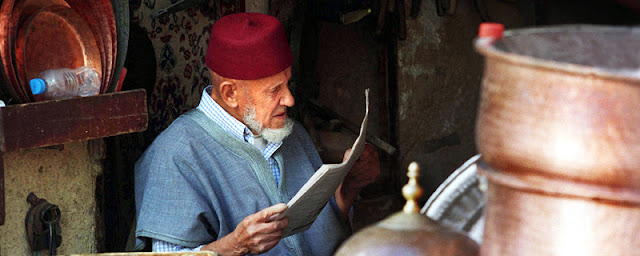This week's L'Economiste carries an interview by Youness Saad Alami with esteemed architect, Rachid Haloui, concerning the current restoration of the most venerated building in the Fez medina, the Moulay Idriss Mausoleum.
 |
| Rachid Haloui |
Haloui explains that the work covers the entire site of the sanctuary, not just the mausoleum. The mausoleum itself comprises the qoubba (dome), the prayer rooms for both men and women and the minaret courtyard, while the rest of the complex includes the Lamgalga Mosque, the latrines, the abbatoir, Dar Qaïtoune and two massriyas.
 |
| Part of the Moulay Idriss Mausoleum |
M Haloui explains that the Minister of the Habous (religious affairs) is sensitive to the heritage value of the buildings he manages. The Moulay Idriss shrine will be restored with total respect towards the materials and decor. It's a case of general consolidation of the buildings and protection against the risks of water damage, safety, plumbing and insect control. Then any decoration that is damaged will be replaced or modified.
As an example, if there's a zellij (mosaic tile) panel that's damaged, it will be restored in situ, supported by mortar behind it that will be laboratory-controlled. Only missing pieces or those badly damaged will be replaced, and in these cases the quality of the materials, the firing of the tiles, the enamel and the colour of each mosaic will be scrupulously controlled. The time envisaged for this work is 24 months.
Asked what kind of difficulties could be encountered in this type of work, M Haloui said that restoration of such buildings is very complex. He has restored many, both in Morocco (in Fez and Essaouira) as well as in France, and says that as a rule, there are always unpleasant surprises. He's never found a pot of gold; it's more likely to be cracks, various degradations, and subsidence. An ancient building often doesn't show its problems on the surface but there will cracks, infiltration of water and damage to decoration. As the mausoleum is a place of worship, the floors are covered by carpets which hide deformations. Difficulties are caused by lots of factors: the very nature of the building, the materials used, what's next door, the nature of the soil as well as lack of maintenance. Very often it's water that causes the greatest problems particularly if there's rising damp.
And the risks involved? M Haloui lists them as being safety and stability during the work, and protection against collapse. This is very serious, of course, and all precautions are taken to protect the building and the workers. Scaffolding is already in place and looks pretty impressive. The other risk is that decoration such as zellij and carved plaster might be further damaged during the work.
See the full article here (in French)

No comments:
Post a Comment